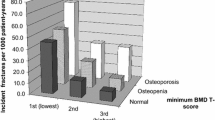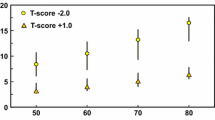Abstract
Summary
The use of areal bone mineral density (aBMD) for fracture prediction may be enhanced by considering bone microarchitectural deterioration. Trabecular bone score (TBS) helped in redefining a significant subset of non-osteoporotic women as a higher risk group.
Introduction
TBS is an index of bone microarchitecture. Our goal was to assess the ability of TBS to predict incident fracture.
Methods
TBS was assessed in 560 postmenopausal women from the Os des Femmes de Lyon cohort, who had a lumbar spine (LS) DXA scan (QDR 4500A, Hologic) between years 2000 and 2001. During a mean follow-up of 7.8 ± 1.3 years, 94 women sustained 112 fragility fractures.
Results
At the time of baseline DXA scan, women with incident fracture were significantly older (70 ± 9 vs. 65 ± 8 years) and had a lower LS_aBMD and LS_TBS (both −0.4SD, p < 0.001) than women without fracture. The magnitude of fracture prediction was similar for LS_aBMD and LS_TBS (odds ratio [95 % confidence interval] = 1.4 [1.2;1.7] and 1.6 [1.2;2.0]). After adjustment for age and prevalent fracture, LS_TBS remained predictive of an increased risk of fracture. Yet, its addition to age, prevalent fracture, and LS_aBMD did not reach the level of significance to improve the fracture prediction. When using the WHO classification, 39 % of fractures occurred in osteoporotic women, 46 % in osteopenic women, and 15 % in women with T-score > −1. Thirty-seven percent of fractures occurred in the lowest quartile of LS_TBS, regardless of BMD. Moreover, 35 % of fractures that occurred in osteopenic women were classified below this LS_TBS threshold.
Conclusion
In conclusion, LS_aBMD and LS_TBS predicted fractures equally well. In our cohort, the addition of LS_TBS to age and LS_aBMD added only limited information on fracture risk prediction. However, using the lowest quartile of LS_TBS helped in redefining a significant subset of non-osteoporotic women as a higher risk group which is important for patient management.


Similar content being viewed by others
References
Marshall D, Johnell O, Wedel H (1996) Meta-analysis of how well measures of bone mineral density predict occurrence of osteoporotic fractures. BMJ 312:1254–1259
Cummings SR, Bates D, Black DM (2002) Clinical use of bone densitometry: scientific review. JAMA 288:1889–1897
Nguyen TV, Center JR, Sambrook PN, Eisman JA (2001) Risk factors for proximal humerus, forearm, and wrist fractures in elderly men and women: the Dubbo Osteoporosis Epidemiology Study. Am J Epidemiol 153:587–595
Schuit SC, van der Klift M, Weel AE, de Laet CE, Burger H, Seeman E, Hofman A, Uitterlinden AG, van Leeuwen JP, Pols HA (2004) Fracture incidence and association with bone mineral density in elderly men and women: the Rotterdam Study. Bone 34:195–202
Sornay-Rendu E, Munoz F, Garnero P, Duboeuf F, Delmas PD (2005) Identification of osteopenic women at high risk of fracture: the OFELY study. J Bone Miner Res 20:1813–1819
Siris ES, Chen YT, Abbott TA, Barrett-Connor E, Miller PD, Wehren LE, Berger ML (2004) Bone mineral density thresholds for pharmacological intervention to prevent fractures. Arch Intern Med 164:1108–1112
NIH Consensus Development Panel (2000) Osteoporosis prevention, diagnosis, and therapy. NIH Consens Statement 17:1–45
Seeman E, Delmas PD (2006) Bone quality—the material and structural basis of bone strength and fragility. N Engl J Med 354:2250–2261
Chappard D, Guggenbuhl P, Legrand E, Basle MF, Audran M (2005) Texture analysis of X-ray radiographs is correlated with bone histomorphometry. J Bone Miner Metab 23:24–29
Pothuaud L, Barthe N, Krieg MA, Mehsen N, Carceller P, Hans D (2009) Evaluation of the potential use of trabecular bone score to complement bone mineral density in the diagnosis of osteoporosis: a preliminary spine BMD-matched, case–control study. J Clin Densitom 12:170–176
Pothuaud L, Carceller P, Hans D (2008) Correlations between grey-level variations in 2D projection images (TBS) and 3D microarchitecture: applications in the study of human trabecular bone microarchitecture. Bone 42:775–787
Winzenrieth R, Michelet F, Hans D (2012) 3D microarchitecture correlations with 2D projection image grey level variations assessed by TBS using high resolution CT acquisitions: effects of resolution and noise. J Clin Densitom. doi:10.1016/j.jocd.2012.05.001
Hans D, Barthe N, Boutroy S, Pothuaud L, Winzenrieth R, Krieg MA (2011) Correlations between trabecular bone score, measured using anteroposterior dual-energy X-ray absorptiometry acquisition, and 3-dimensional parameters of bone microarchitecture: an experimental study on human cadaver vertebrae. J Clin Densitom 14:302–312
Rabier B, Heraud A, Grand-Lenoir C, Winzenrieth R, Hans D (2010) A multicentre, retrospective case–control study assessing the role of trabecular bone score (TBS) in menopausal Caucasian women with low areal bone mineral density (BMDa): analysing the odds of vertebral fracture. Bone 46:176–181
Winzenrieth R, Dufour R, Pothuaud L, Hans D (2010) A retrospective case–control study assessing the role of trabecular bone score in postmenopausal Caucasian women with osteopenia: analyzing the odds of vertebral fracture. Calcif Tissue Int 86:104–109
Hans D, Goertzen AL, Krieg MA, Leslie WD (2011) Bone microarchitecture assessed by TBS predicts osteoporotic fractures independent of bone density: the Manitoba study. J Bone Miner Res 26:2762–2769
Arlot ME, Sornay-Rendu E, Garnero P, Vey-Marty B, Delmas PD (1997) Apparent pre- and postmenopausal bone loss evaluated by DXA at different skeletal sites in women: the OFELY cohort. J Bone Miner Res 12:683–690
Genant HK, Wu CY, van Kuijk C, Nevitt MC (1993) Vertebral fracture assessment using a semiquantitative technique. J Bone Miner Res 8:1137–1148
Wegrzyn J, Roux JP, Arlot ME, Boutroy S, Vilayphiou N, Guyen O, Delmas PD, Chapurlat R, Bouxsein ML (2010) Role of trabecular microarchitecture and its heterogeneity parameters in the mechanical behavior of ex vivo human L3 vertebrae. J Bone Miner Res 25:2324–2331
Del Rio LM, Winzenrieth R, Cormier C, Di Gregorio S (2012) Is bone microarchitecture status of the lumbar spine assessed by TBS related to femoral neck fracture? A Spanish case–control study. Osteoporos Int. doi:10.1007/s00198-012-2008-8
Krueger D, Fidler E, Libber J, Aubry-Rosier B, Hans D, Binkley N (2012) Spine trabecular bone score (TBS) subsequent to BMD improves vertebral and op fracture discrimination in women. Osteoporos Int 23(Suppl 2):S336
Roux JP, Wegrzyn J, Boutroy S, Hans D, Chapurlat RD (2012) Relationship between trabecular bone score (TBS), bone mass and microarchitecture in human vertebrae: an ex vivo study. Osteoporos Int 23(Suppl 2):S327
Vasic J, Gojkovic F, Petranova T, Elez J, Culafic Vojinovic V, Winzenrieth R, Hans D, Rashkov R, Dimic A (2012) Spine micro-architecture estimation (TBS) discriminates major osteoporotic fracture from controls equally well than site matched BMD and independently: the eastern europe TBS study. Osteoporos Int 23(Suppl 2):S337
Popp AW, Meer S, Krieg MA, Perrelet R, Hans D, Lippuner K (2012) Bone mineral density (BMD) combined with micro-architecture parameters (TBS) significantly improves the indentification of women at high risk of fracture: the SEMOF cohort study. Osteoporos Int 23(Suppl 2):S327
Dufour R, Heraud A (2009) Lumbar spine micro-architecture in french women derived from DXA: TBS normative data. J Clin Densitom 12:377–378
Bloch JG, Hans D, Diebolt V, Kieffer D, Krieg MA (2008) Evaluation du risque fracturaire dans la zone d’ostéopénie: utilisation clinique d’un indice de la microarchitecture osseuse (TBS: trabéculométrie et trabéculographie). In: Proceedings of the SFR annual meeting, Paris, 14–17 Dec 2008
Lamy O, Metzger M, Krieg MA, Aubry-Rozier B, Stoll D, Hans D (2011) OsteoLaus: prediction of osteoporotic fractures by clinical risk factors and DXA, IVA and TBS. Rev Med Suisse 7:2130, 2132–2134, 2136
Albrand G, Munoz F, Sornay-Rendu E, DuBoeuf F, Delmas PD (2003) Independent predictors of all osteoporosis-related fractures in healthy postmenopausal women: the OFELY study. Bone 32:78–85
Sornay-Rendu E, Munoz F, Delmas PD, Chapurlat RD (2010) The FRAX tool in French women: how well does it describe the real incidence of fracture in the OFELY cohort? J Bone Miner Res 25:2101–2107
Winzenrieth R, Dufour R, Popova Y, Hans D (2010) Spine osteo-arthrosis has no effect on TBS assessment: a site matched study with BMD. J Clin Densitom 13:130–131
Conflicts of interest
TBS iNsight Software is a product of Med-Imaps. Didier Hans is a co-owner of the TBS patent and has corresponding ownership shares. Renaud Winzenrieth is a scientific consultant for Med-Imaps. All the other authors state that they have no conflicts of interest.
Author information
Authors and Affiliations
Corresponding author
Rights and permissions
About this article
Cite this article
Boutroy, S., Hans, D., Sornay-Rendu, E. et al. Trabecular bone score improves fracture risk prediction in non-osteoporotic women: the OFELY study. Osteoporos Int 24, 77–85 (2013). https://doi.org/10.1007/s00198-012-2188-2
Received:
Accepted:
Published:
Issue Date:
DOI: https://doi.org/10.1007/s00198-012-2188-2




